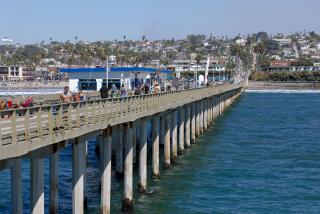Trying to Stay Afloat : Lack of Money for Repairs Is Taking Its Toll on Collection of Old Ships
- Share via
SAN FRANCISCO — Time, rot and a shortage of money are taking their toll on the United States’ premier collection of old ships, officials and fans of the vessels say.
One of the ships, the 204-foot Wapama, is a mass of rotting timbers. It rests on a barge in Oakland Estuary.
Officials fear that other ships in the National Maritime Museum collection, although still afloat, may have undetected damage as bad as that of the Wapama.
“Right now, I’d estimate we should be spending $3 million a year in maintenance, but we’re spending about half that,” said Brian O’Neill, acting superintendent of the Golden Gate National Recreation Area, where the ships are tied up.
“I know I’ve got a real missionary job with the (National) Park Service, getting them to understand what we need to do and the money we need to do it,” O’Neill added.
Actually, the maintenance budget for the ships in the current fiscal year is about $1 million, down from $1.5 million last year.
O’Neill, who called the ships “the largest maritime resource the federal government has,” said the government needs a “grand plan, a vision, a goal that everyone can get behind,” to save the collection.
Harry Dring, who was the foreman in charge of maintaining the historic ships before he retired, said what the government needs to do is “get some ship people in there who know what these old ships need, then give them the resources to do it.”
“These people they have calling the shots today just don’t have the background for the job they have to do,” the 66-year-old Dring said. “They are all good people, but their background is in administration, paper work, not old wooden ships.”
The Wapama, a 1915 schooner that once hauled lumber and passengers up and down the Pacific coast, has been sitting on a barge since 1980, waiting for what was to be a three-year, $2.8-million repair project.
After Dring retired, the effort came to a halt. Now the vessel collects rainwater in its hold as the $8,300-per-month rent for the barge piles up.
A survey of the ship is now under way by Guilford Full, a noted marine surveyor.
“We won’t know what we have to do (to repair it) until we get the facts,” O’Neill said.
Five of the six other major ships in the fleet are tied up at the Hyde Street Pier, at the northern end of San Francisco. The sixth, the Balclutha, is at nearby Fisherman’s Wharf.
Ray Aker, a retired sea captain who is head of Friends of the Historic Ships, a volunteer group, wants to move the vessels to the China Basin, which is a more protected spot on the city’s eastern side. Now the ships are pounded by swells and bumped against the pier.
Completion of a breakwater will reduce that wear and tear but there is fear that the pounding will continue, particularly during storms.
Aker said the ships should be under a separate agency--”away from the politics and struggle for funds in the Park Service.”
Besides the Wapama, the fleet includes:
- The Balclutha, a 256-foot, three-masted steel ship that was built in Scotland in 1889. It was used for 28 years in the Alaskan salmon packing trade.
- The Eureka, a 300-foot, San Francisco Bay ferryboat that was built in 1890.
- The C. A. Thayer, a 156-foot, wooden, three-masted Pacific coast lumber schooner that was built around 1895.
- The Alma, an 1891 flat-bottom hay schooner that was built in 1891.
- The Hercules, a 150-foot deep-sea tugboat that was built in 1907 and used along the Pacific coast until 1963.
- The Eppleton Hall, a 1914 paddle-wheel river tugboat from England. It was brought to San Francisco several years ago by a private group via an 11,000-mile voyage.
There are also scores of lesser ships in the collection.
More to Read
Sign up for Essential California
The most important California stories and recommendations in your inbox every morning.
You may occasionally receive promotional content from the Los Angeles Times.













